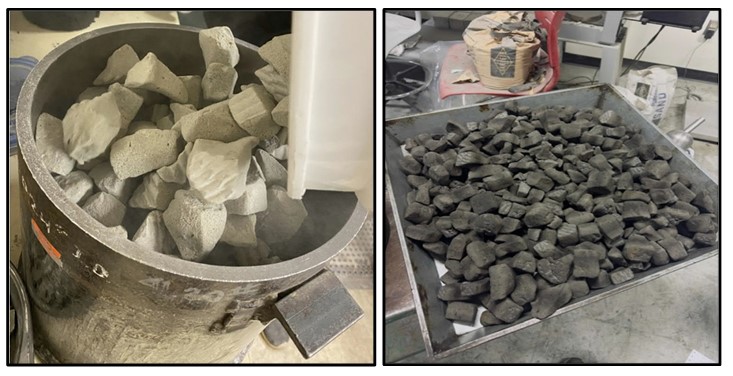Recycled and lightweight fill materials are increasingly used in construction. They can address challenging site conditions, accelerate project timelines, and reduce reliance on natural resources while contributing to an agency’s sustainability goals. This project investigated the use of one such material, foamed glass aggregate, for the Illinois State Toll Highway Authority.
Foamed glass aggregate (FGA) is a processed recycled aggregate made from waste glass. The manufacturing process involves grinding the glass into powder, melting it at high temperatures (approximately 1600°F) with a foaming agent, and cooling it to form lightweight, angular particles.
FGA is notable for its low dry unit weight (8 to 15 pounds per cubic foot), which can help minimize the risk of settlement and reduce the need for extensive soil excavation. In addition to its low weight, FGA possesses several other unique engineering properties, such as a high friction angle, good thermal insulation, and high permeability. The material has been employed in various states for highway embankments, retaining wall backfill, and bridge abutments.
Given the unique properties of FGA, its utilization could be a sustainable practice. However, despite its advantages, FGA presents several characteristics that require further investigation. Excessive compaction during placement can crush the material, generating fines and reducing its volume. The behavior of FGA under dynamic traffic warrants further investigation. Additionally, its low density raises concerns regarding buoyancy during flooding and susceptibility to wind erosion. Therefore, as with any emerging or unconventional material, a comprehensive engineering study of FGA is essential before it is widely used.
To that end, the research team conducted extensive literature reviews and surveys. They then procured two types of FGA samples (wet and dry foaming) and two conventional soils (sand and embankment clay, used as a reference) for laboratory experiments. These experiments included testing for basic FGA characteristics, gradations, volumetric and electrochemical properties, aerodynamic properties, and axial compression compaction, as well as conducting one-dimensional consolidation tests, dynamic triaxial tests, and direct shear tests. In addition, the researchers studied a pilot construction and performed economic and environmental analyses.
The experiments produced results regarding water absorption rates; organic, sulfate, and chloride contents; erosion under high wind conditions; compaction approaches; compression; friction angles; and plastic deformation and resilient modulus. The field pilot construction demonstrated that measuring elevation changes is an effective method for FGA compaction acceptance. The economic analysis indicated that the cost of FGA can be significantly affected by shipping distance, and FGA prices are higher than those of lightweight cellular concrete (LCC). However, FGAs are a more environmentally sustainable option than LCC in terms of reducing greenhouse gas emissions and resource use.
Authors:
Haifang Wen
Shafkat Bin Jafar
Mohammadreza Barzegar
Michael P. McGuire
Tuncer Edil
WSU Department of Civil and Environmental Engineering
Sponsor: Illinois State Toll Highway Authority

